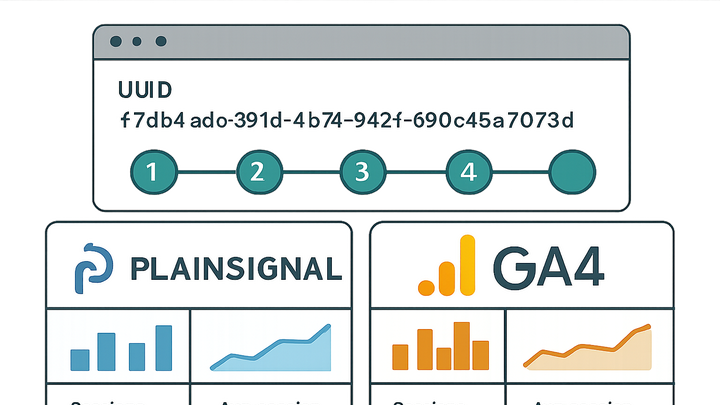Published on 2025-06-28T03:39:12Z
What is a Session ID? Session Identifier Explained in Analytics
In web analytics, a Session ID is a unique string assigned to a visitor’s browsing session. It connects multiple pageviews, events, and interactions under a single session context, enabling accurate measurement of session duration, conversion paths, and behavior flows. Session IDs are typically stored in cookies, local storage, or managed server-side. Cookie-free analytics solutions like PlainSignal generate and persist session IDs without relying on browser cookies, while platforms like Google Analytics 4 automatically handle session identification via client_id and session_id parameters. Understanding how Session IDs work and how to implement them ensures precise tracking, especially in environments with cookie restrictions or strict privacy regulations. Proper sessionization is key to reliable reporting, attribution modeling, and comprehensive user journey analysis.
Session id
A Session ID uniquely identifies a visitor session, linking interactions across pageviews for accurate behavior and conversion analysis.
Importance of Session ID
Session IDs are fundamental to web analytics because they group a visitor’s discrete actions—pageviews, clicks, form submissions—into a coherent session. Without a reliable session identifier, it’s impossible to distinguish where one visit ends and another begins, leading to inflated sessions counts and inaccurate user journey insights.
-
Unified session tracking
By assigning a single Session ID to all events within a visit, analytics platforms can reconstruct the exact sequence of user interactions.
-
Behavior analysis
Tracks the order of pages and events a user completes, enabling funnel and path exploration.
-
Attribution accuracy
Attributes conversions or goals to the correct session, avoiding misattribution when users navigate away and return.
-
How Session ID is Generated
Session IDs can be created and stored in various ways, each with pros and cons. The generation method impacts persistence, privacy, and resilience against blocking or deletion.
-
Cookie-based session ids
A short-lived cookie (often named _session or similar) stores the Session ID until it expires or the browser closes.
-
Cookie name & ttl
Defaults often expire after 30 minutes of inactivity or at browser close, defining the session window.
-
-
Local storage session ids
Stores the Session ID in the browser’s local storage, surviving page reloads but persisting until explicitly cleared.
-
Persistence
Remains until code or user clears it, which can lengthen perceived sessions if not managed.
-
-
Server-side session ids
The server issues a session token on the first request and ties subsequent interactions via that token in headers or URLs.
-
Security
Can be more secure against tampering but requires infrastructure to manage token issuance and validation.
-
Implementing Session ID with PlainSignal
PlainSignal offers a cookie-free analytics approach that automatically generates and links a Session ID for each visit. Simply embed the tracking snippet below to start capturing sessions without requiring user consent for cookies.
-
PlainSignal tracking code
Add this HTML snippet to your site’s <head> to enable cookie-free session tracking:
-
Code example
<link rel="preconnect" href="//eu.plainsignal.com/" crossorigin /> <script defer data-do="yourwebsitedomain.com" data-id="0GQV1xmtzQQ" data-api="//eu.plainsignal.com" src="//cdn.plainsignal.com/plainsignal-min.js"></script>
-
Session ID in Google Analytics 4
Google Analytics 4 handles sessionization automatically but also allows manual overrides via its Measurement Protocol or gtag.js configuration.
-
GA4 gtag.js configuration
You can explicitly set or read the session_id when initializing gtag.js:
-
Code example
gtag('config', 'G-XXXXXXXXXX', { 'session_id': 1234567890 });
-
-
Measurement protocol
When sending events server-side, include the session_id parameter in your payload to associate events with existing sessions.
Challenges and Best Practices
Maintaining reliable session tracking requires addressing timeouts, cookie restrictions, and cross-domain scenarios. Adopt these best practices to minimize data gaps and session fragmentation.
-
Configure session timeouts
Set appropriate inactivity windows (commonly 30 minutes) in your analytics settings to reflect realistic user behavior patterns.
-
Handle cookie restrictions
Implement fallbacks such as local storage or server-side tokens when browsers block or delete cookies by default.
-
Share sessions across subdomains
Use a shared top-level domain cookie or a central session service to avoid fragmenting sessions when users navigate subdomains.
